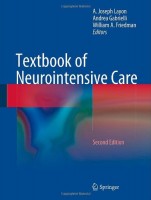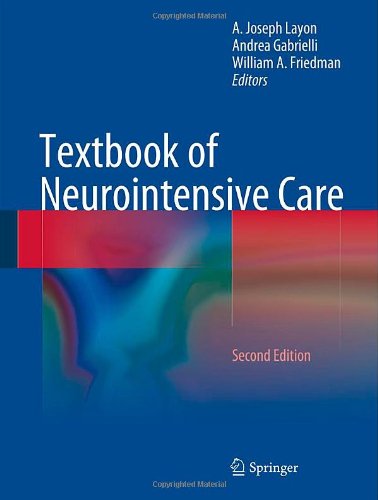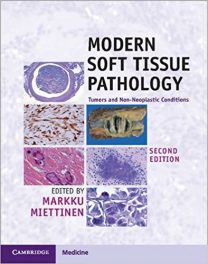 Editors: A. Joseph Layon, Andrea Gabrielli, and William A. Friedman
Editors: A. Joseph Layon, Andrea Gabrielli, and William A. Friedman
Publisher: Springer – 988 pages
Book Review by: Nano Khilnani
A lot of new knowledge – through research in the laboratory and practice in hospitals – has been gathered in the nine years since the first edition of this textbook appeared, and much of that has been incorporated in this new edition.
This book is the collective hard work of those scientists and clinicians who are at the forefront of the effort to better understand the causes of the neurologic diseases that afflict some of us, and to better treat them.
There is, as the expression goes, ‘a ton’ of information in this book, and in order not to overwhelm you with the size and variety of it, the editors have organized it around just six sections, namely:
- Introduction
- Neuroanatomy and Pathophysiology
- Neuromonitoring
- The Neuroinjured Patient and Critical Care Medicine
- Special Situations
- Situations of Special Interest
One hundred and four specialists from the United States (about a third of whom are affiliated in some way with the University of Florida College of Medicine in Gainesville), Brazil, Italy and Japan authored the 46 chapters of this book of nearly a thousand pages.
Most of the contributors to this volume are physicians and surgeons at medical centers and / or professors at universities in fields relating to the neurosciences, but some are in other fields: anesthesiology, cardiology, critical care medicine, emergency medicine, hematology, nephrology, oncology, pathology, and radiology. Since the nervous system affects all parts of the human body, in actual fact, no medical specialty can be totally unrelated to neurology.
In this book, you will find information on many common (and some not-so-common) neurological conditions, disorders, and diseases. Below we name just a few beginning with letters A through H:
Acute intermittent hemodialysis (IHD), acute ischemic stroke (AIS), acute respiratory distress syndrome (ARDS), Alzheimer’s disease, aneurysm, Asperger syndrome;
Bacterial meningitis, Barotrauma, Bartonellosis, blastomycosis, bone marrow aplasia, brain death, brain tumors, Broca’s aphasia, Brown-Sequard syndrome;
Central pontine myelinolysis (CPM), cerebral autosomal dominant arteriopathy with subcortical infarcts (CADASIL), cerebral herniation, cerebral hyperglycolysis, cerebral vasospasm;
Deep vein thrombosis, delayed ischemic neurologic deficits (DINDs), delirium, drug intoxication, dialysis disequilibrium syndrome, Duchenne muscular dystrophy (DMD);
Ehler-Danlos syndrome, Ehrlichiosis, encephalitis, endocarditis, epilepsy, erythrocytosis, extrapyramidal disorders;
Fronto-temporal dementia (FTD), fungal central nervous system (CNS) infections, such as : coccidiodal meningitis, cryptococcus meningitis, fungal meningitis, histoplasmosis;
Germ cell tumors, Gerstmann’s syndrome, gliomas, Giullain-Barre syndrome (GBS);
Hashimoto’s thyroiditis, hematologic disorders, heterotopic ossification, Hoffman twitching, homonymous hemianopia, Horner’s syndrome, hyperkalemia, hyponatremia, hypoxemia.
The materials in the chapters are superbly organized. Laid out in two-column format, each chapter’s first page begins with Contents on the left column, detailing what you will find on the left, and page numbers on the right.
Information on the chapter authors including their professional affiliations, addresses, and email contacts are provided on the bottom left of that first page, The right column begins with an Abstract that provides a summary of what you will find in that chapter.
A section entitled Keywords follows at the end of the Abstract section. The topics of discussion are then presented in the chapter, interspersed with drawings, magnetic resonance images (MRIs), photos (of instruments, patients, procedures, etc.), tables and other visuals are presented.
The chapters end with a brief Summary and a list of References for further study.
The coverage of this book is quite comprehensive; its organization of content very streamlined; and its layout very pleasing to the eye, and makes for easier reading, learning, and retention. What adds great value to this book is the contribution of more than a hundred specialists (authors and editors) in the neurosciences and in other fields.
Editors:
A Joseph Layon, MD, FACP is with the Department of Pulmonary and Critical Care Medicine at Gestetner Health System in Danville, Pennsylvania, and with Temple University School of Medicine in Philadelphia, Pennsylvania.
Andrea Gabrielli, MD, FCCM is with the Department of Anesthesiology and Surgery at University of Florida College of Medicine in Gainesville, Florida.
William A. Friedman, MD is with the Department of Neurological Surgery at University of Florida College of Medicine in Gainesville, Florida.







